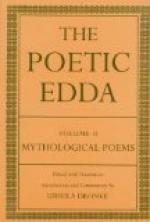The motives of heroic tales are limited in number and more or less common to different races. Heroic cycles differ as a rule merely in their choice or combination of incidents, not in the nature of their material. The origin of these heroic motives may generally be found in primitive custom or conditions of life, seized by an imaginative people and woven into legend; sometimes linked to the name of some dead tribal hero, just as the poets of a later date wound the same traditions in still-varying combinations round the names of Gretti Asmundarson and Gold-Thori; though often the hero is, like the Gods, born of the myth. In the latter case, the story is pure myth; in the former it is legend, or a mixture of history and legend, as in the Ermanric and Dietrich tales, which have less interest for the mythologist.
The curse-bringing treasure, one of the most fruitful Germanic motives, probably has its origin in the custom of burying a dead man’s possessions with him. In the Waterdale Saga, Ketil Raum, a viking of the eighth and early ninth centuries, reproaches his son Thorstein as a degenerate, in that he expects to inherit his father’s wealth, instead of winning fortune for himself: “It used to be the custom with kings and earls, men of our kind, that they won for themselves fortune and fame; wealth was not counted as a heritage, nor would sons inherit from their fathers, but rather lay their possessions in the howe with them.” It is easy to see that when this custom came into conflict with the son’s natural desire to inherit, the sacrosanctity of the dead man’s treasure and of his burial-mound would be their only protection against violation. The fear of the consequences of breaking the custom took form in the myth of the curse, as in the sword of Angantyr and the Nibelungs’ hoard; while the dangers attending the violation of the howe were personified in the dragon-guardian. In Gold-Thori’s Saga, the dead berserks whose howe Thori enters, are found guarding their treasure in the shape of dragons; while Thori himself is said to have turned into a dragon after death.




